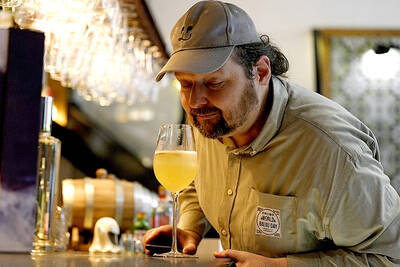The Taichung Jazz Festival (台中爵士音樂節) welcomes the autumn season with a diversity of jazz styles, ranging from the be-bop avant-garde sounds of Italian trumpeter Enrico Rava and the tango-infused music of French accordionist Richard Galliano to the vocal harmonizing of German group Stouxingers and the electric blues of Joey Gilmore.
The festival, which starts tomorrow and runs until Oct. 25, continues to grow. Last year the event attracted around 290,000 people, according to the Taichung Cultural Affairs Bureau. The bureau touts the festival as “the nation’s largest,” and expects to break the 300,000 mark for attendance this year.
The event takes place along the city’s scenic Jingguo Boulevard Parkway (經國綠園道), with the main acts performing at Civic Square (市民廣場).
Many of this year’s acts hail from Europe. Enrico Rava, tomorrow night’s headliner, is one of Italy’s most prominent jazz musicians and a veteran of the international scene. The 70-year-old trumpeter started his career working with Latin jazz saxophonist Gato Barbieri and dabbled in free jazz and avant-garde throughout the mid-1960s, while playing in a quartet with soprano saxophonist Steve Lacy. Rava now mainly performs be-bop.
French accordionist Richard Galliano and his quartet take the stage next Sunday. Galliano, a highly revered figure among accordionists, draws from diverse roots, spanning Mediterranean folk, French Chanson and Musette and classical music. But careful listeners can also discern a clear tango influence. Galliano has worked with Astor Piazzolla and includes the Argentine composer’s work in his repertoire.
The Stouxingers are a German a capella group, distinguished by their ability to sound like a full band with instrumentation. The award-winning sextet not only sings lyrics, but also reels out an array of unconventional noises — they click their tongues in rhythm, beat-box and imitate brass horns with their voices. The group performs next Sunday. The program also pays heed to jazz’s roots by featuring American blues-man Joey Gilmore tomorrow night.
The 65-year-old guitarist and singer has spent the last week wowing audiences in Taipei with his soulful singing and deft guitar work. Blues fans shouldn’t pass up this last chance to see Gilmore, who won the International Blues Challenge in 2006, a major competition held by the Blues Foundation in Memphis. He appears tomorrow at 7pm in Civic Square and later in the evening at 10:30pm in Hotel One in Taichung, located at 532 Yingcai Rd, Taichung City (台中市英才路532號).
Nearly 40 acts from both Taiwan and abroad are also scheduled to perform. For the full schedule, visit the festival Web site at www.jazzfestival.com.tw.

The unexpected collapse of the recall campaigns is being viewed through many lenses, most of them skewed and self-absorbed. The international media unsurprisingly focuses on what they perceive as the message that Taiwanese voters were sending in the failure of the mass recall, especially to China, the US and to friendly Western nations. This made some sense prior to early last month. One of the main arguments used by recall campaigners for recalling Chinese Nationalist Party (KMT) lawmakers was that they were too pro-China, and by extension not to be trusted with defending the nation. Also by extension, that argument could be

Aug. 4 to Aug. 10 When Coca-Cola finally pushed its way into Taiwan’s market in 1968, it allegedly vowed to wipe out its major domestic rival Hey Song within five years. But Hey Song, which began as a manual operation in a family cow shed in 1925, had proven its resilience, surviving numerous setbacks — including the loss of autonomy and nearly all its assets due to the Japanese colonial government’s wartime economic policy. By the 1960s, Hey Song had risen to the top of Taiwan’s beverage industry. This success was driven not only by president Chang Wen-chi’s

Last week, on the heels of the recall election that turned out so badly for Taiwan, came the news that US President Donald Trump had blocked the transit of President William Lai (賴清德) through the US on his way to Latin America. A few days later the international media reported that in June a scheduled visit by Minister of National Defense Wellington Koo (顧立雄) for high level meetings was canceled by the US after China’s President Xi Jinping (習近平) asked Trump to curb US engagement with Taiwan during a June phone call. The cancellation of Lai’s transit was a gaudy

The centuries-old fiery Chinese spirit baijiu (白酒), long associated with business dinners, is being reshaped to appeal to younger generations as its makers adapt to changing times. Mostly distilled from sorghum, the clear but pungent liquor contains as much as 60 percent alcohol. It’s the usual choice for toasts of gan bei (乾杯), the Chinese expression for bottoms up, and raucous drinking games. “If you like to drink spirits and you’ve never had baijiu, it’s kind of like eating noodles but you’ve never had spaghetti,” said Jim Boyce, a Canadian writer and wine expert who founded World Baijiu Day a decade